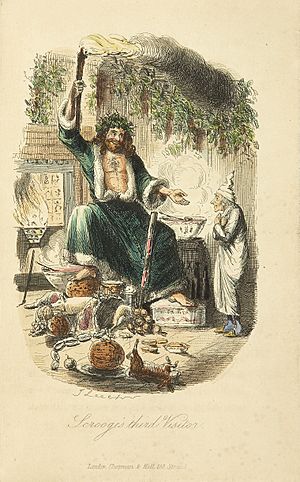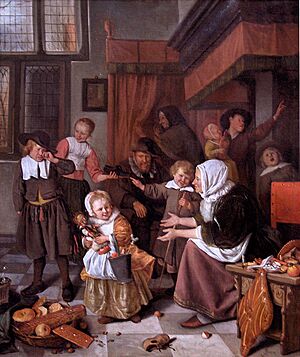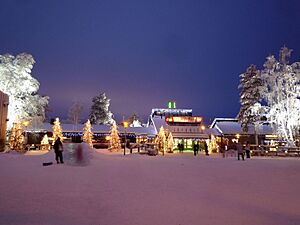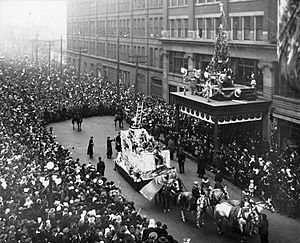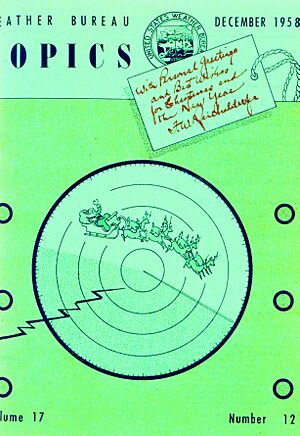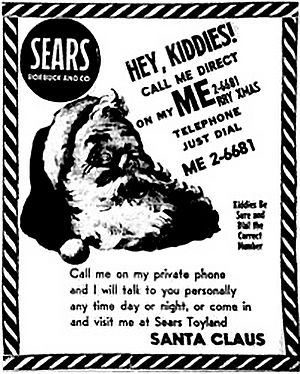Santa Claus facts for kids
Quick facts for kids Santa Claus |
|
|---|---|
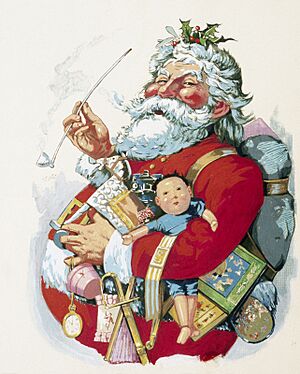
1863 illustration by Thomas Nast
|
|
| Associates |
|
| Attire | Santa suit |
| Aliases | Saint Nicholas, Father Christmas, Saint Nick, Kris Kringle, Santa, Mr. Claus |
| Gender | Male |
| Occupation | Delivering gifts to children on Christmas |
| Spouse | Mrs. Claus |
| Home | |
Santa Claus (also known as Santa, Saint Nicholas, Saint Nick, Father Christmas or Kris Kringle) is a famous figure from Western Christian culture. People say he brings gifts during the late evening and overnight hours on Christmas Eve. Christmas elves are believed to make the gifts in Santa's workshop. Meanwhile, flying reindeer pull his sleigh through the air.
The popular idea of Santa Claus comes from old stories about Saint Nicholas, a Christian bishop from the 4th century. Saint Nicholas was known for being very generous and secretly giving gifts. The image of Santa Claus is similar to the English figure of Father Christmas. Today, many people think they are the same person.
Santa is usually shown as a cheerful, white-bearded man with a round belly. He often wears glasses and a red coat with white fur. His outfit includes red trousers, a red hat, a black belt, and boots. He carries a big bag full of gifts for children. People often imagine him with a deep, happy laugh, which sounds like "ho, ho, ho!"
This image first became popular in the United States in the 1800s. Dutch settlers brought the legend of Sinterklaas ("Saint Nicholas") to New Amsterdam (now New York City) in the 1600s. An American poem from 1823, "A Visit from St. Nicholas", helped shape modern Santa. It described Saint Nicholas arriving on Christmas Eve in a sleigh pulled by flying reindeer. Over time, songs, TV shows, books, movies, and advertisements have kept this image strong.
The Story of Santa Claus
Who Was Saint Nicholas?
Saint Nicholas was a Greek Christian bishop in the 4th century. He lived in Myra, which is now part of Turkey. Nicholas was famous for his kindness and for giving gifts to people in need. One story tells how he secretly helped three poor daughters get married by providing them with money. He was very religious from a young age and dedicated his life to Christianity. In many parts of Europe, he is shown as a bearded bishop in church robes.
In 1087, some merchants from the Italian city of Bari took Saint Nicholas's bones from his tomb in Myra. They brought them to Bari, where they are now kept in a church. Later, other sailors took smaller bone fragments to Venice. Saint Nicholas became the patron saint (a special protector) of many groups. These included archers, sailors, children, and even pawnbrokers. He is also the patron saint of Amsterdam and Moscow.
During the Middle Ages, children often received gifts in his honor on December 5th, the evening before his feast day. Later, during a time called the Reformation, this gift-giving tradition moved to December 24th and 25th. This change helped focus Christmas celebrations more on Christ.
Father Christmas and Other Gift-Givers
Father Christmas first appeared in 16th-century England. He was often shown as a large man in green or red robes lined with fur. He represented the joyful spirit of Christmas, bringing peace, happiness, good food, and celebrations. Since England no longer celebrated Saint Nicholas on December 6th, Father Christmas's celebration moved to December 25th. During the Victorian era, he became a symbol of good cheer. His look varied, but he was often seen as a kind, jolly man.
European Traditions of Gift-Giving
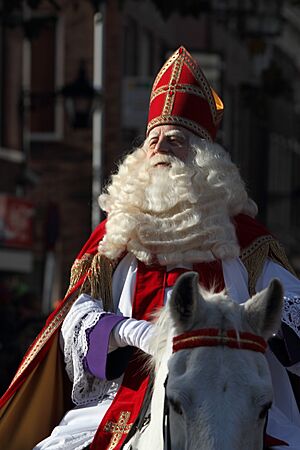
In the Netherlands and Belgium, children know both Santa Claus and Sinterklaas. Sinterklaas is based on Saint Nicholas. Santa Claus is called de Kerstman (the Christmas man) in Dutch and Père Noël (Father Christmas) in French. In the Netherlands, Sinterklaas is the main gift-giver on December 5th. Some families give gifts on both Sinterklaas evening and Christmas Day. In Belgium, children get presents on December 6th, and everyone might get gifts on Christmas Day. Sinterklaas has helpers called "Pieten" or "Père Fouettard", who are not elves.
In Switzerland, Père Fouettard joins Père Noël in French-speaking areas. In German-speaking Switzerland, a character called Schmutzli accompanies Samichlaus. Schmutzli carries a twig broom to remind naughty children to be good.
Ancient Winter Celebrations
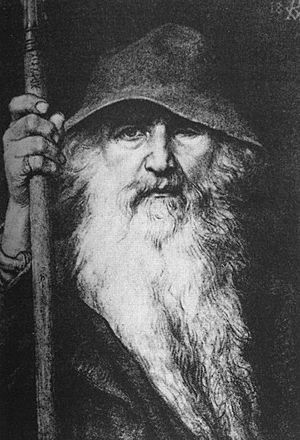
Before Christianity spread, Germanic people celebrated a midwinter event called Yule. Many Yule traditions became part of modern Christmas. For example, the god Odin was sometimes called "Yule man" and "long-beard." He was said to lead a "Wild Hunt" across the winter sky.
Some people believe Odin's stories influenced the idea of Saint Nicholas and Santa Claus. This includes his long white beard and his horse for night rides. Odin was seen as a gift-bringer who visited people with presents. This ancient figure, along with Saint Nicholas, helped shape the Santa Claus we know today. In northern Europe, the Yule goat was also an early gift-bringer. It has now blended with Santa Claus in some traditions, like the Finnish Joulupukki.
How Santa Claus Became Popular
Santa's Look and Reindeer
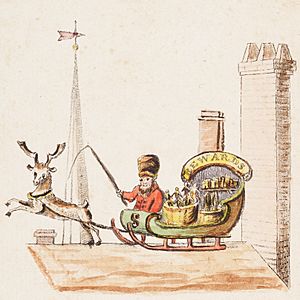
Early stories of gift-givers, especially Saint Nicholas, combined with the English Father Christmas. This created the character known as "Santa Claus." The name "Santa Claus" comes from the Dutch "Sinterklaas."
In the early American colonies, British and Dutch ideas of the gift-giver mixed even more. In 1809, a book by Washington Irving called History of New York described Sinterklaas. He was called "Santa Claus" for the first time in the U.S. press in 1773. Irving's Santa was a thick-bellied Dutch sailor with a pipe. This book helped make Christmas celebrations more family-friendly.
In 1821, a book called A New-year's present featured a poem, "Old Santeclaus with Much Delight." It described Santeclaus in a reindeer sleigh, bringing rewards to children. The famous poem "A Visit From St. Nicholas" (also known as The Night Before Christmas) was published in 1823. It described Saint Nicholas as "chubby and plump, a right jolly old elf" with a belly that "shook when he laughed like a bowlful of jelly." This poem also named his reindeer: Dasher, Dancer, Prancer, Vixen, Comet, Cupid, Dunder, and Blixem. Dunder and Blixem later became Donner and Blitzen.
By 1845, "Kris Kringle" (from the German "Christkindl," meaning "Christ-child") was another name for Santa. People in different parts of the United States used different names for the gift-giver.

The cartoonist Thomas Nast helped create Santa's modern image in the 1800s. His illustrations for Harper's Weekly showed Santa in a red suit. Nast was inspired by the Belsnickel, a folklore figure from Germany. He also drew Santa in a sleigh pulled by reindeer.
Nast might also be the one who started the idea that Santa lives at the North Pole. An 1866 illustration by Nast included the caption "Santa Claussville, N.P." By the 1870s, this idea was well-known. The idea of Mrs. Claus also appeared in the mid-1800s. Poet Katharine Lee Bates made Mrs. Claus popular in her 1889 poem "Goody Santa Claus on a Sleigh Ride." In 1897, the famous editorial "Yes, Virginia, there is a Santa Claus" was published in The New York Sun.
Santa in the 20th Century
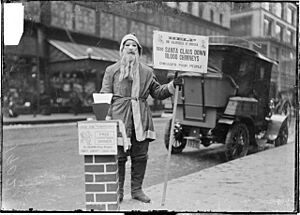
In 1902, L. Frank Baum published The Life and Adventures of Santa Claus. This children's book added many details to Santa's story. It gave him a home in the Laughing Valley of Hohaho and ten reindeer. The book explained that Santa wanted to bring joy to all children. He invented toys as a way to do this.
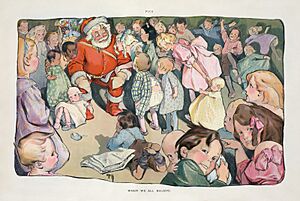
Haddon Sundblom's drawings for The Coca-Cola Company's Christmas ads in the 1930s made Santa's image even more famous. Some people mistakenly believe Coca-Cola invented Santa or his red suit. However, Santa had appeared in red and white before these ads. Other companies, like White Rock Beverages, also used Santa in their ads earlier.
Santa Claus became linked with charity and helping others. Groups like the Salvation Army often have volunteers dressed as Santa. They raise money to help families in need during Christmas.
In 1937, Charles W. Howard started the Charles W. Howard Santa School. It is the oldest school of its kind in the world. In the early 1900s, Santa was sometimes shown making toys himself. Later, the idea of many elves helping him in a workshop became popular.
The song "Mrs. Santa Claus" (1956) and the book How Mrs. Santa Claus Saved Christmas (1963) helped establish Mrs Claus's role. Another famous addition is Rudolph the Red-Nosed Reindeer. He was created in 1939 by Robert L. May and became famous through a 1949 song by Gene Autry.
Santa's Traditions Around the World
How Gifts Are Delivered
Many European stories say that seasonal gift-givers enter homes through the chimney. This tradition is also part of the Santa Claus story.
On Christmas Eve, after children are asleep, parents often place gifts under the Christmas tree. These gifts might be signed as being "from Santa Claus."
In Hungary, Saint Nicolaus (Mikulás) or Father Winter (Télapó) visits on the night of December 5th. Children receive gifts the next morning. If they were good, they get sweets. On Christmas Eve, "Little Jesus" brings gifts for everyone.
In Slovenia, Saint Nicholas (Miklavž) also brings small gifts for good children on the eve of December 6th. Božiček (Christmas Man) brings gifts on the eve of December 25th. Dedek Mraz (Grandfather Frost) brings gifts on the evening of December 31st, to be opened on New Year's Day.
What Santa Looks Like
Santa is generally shown as a cheerful, white-bearded man with glasses. He wears a red jacket, trousers, and hat, all trimmed with white fur. He also has a black leather belt and boots. He carries a bag full of gifts for children. The 1823 poem "A Visit from St. Nicholas" and cartoonist Thomas Nast helped make this image popular. Some people have compared Santa's red-and-white outfit to the camauro, a soft red hat with white fur once worn by the pope.
The 1823 Christmas poem says Santa has "a little round belly / That shook when he laugh'd, like a bowl full of jelly." While usually shown as white, Santa is sometimes depicted as black or other races.
Santa's Famous Laugh
Ho ho ho is how many languages write out Santa Claus's laugh. It's a deep, happy chuckle, most often linked with Santa Claus and Father Christmas. This laugh is an important way to identify the character in many English-speaking countries.
Where Does Santa Live?
Santa Claus's home traditionally includes a house and a workshop. There, he is said to create gifts, often with the help of elves. These gifts are then delivered to good children at Christmas. Some stories even describe a village around his home, where his helpers live.
Santa is traditionally said to live at the North Pole. Canada Post even has a special postal code for him: H0H 0H0. On December 23, 2008, the Canadian government officially gave Santa Claus Canadian citizenship. This means he has the right to re-enter Canada after his trip around the world. There is also a city called North Pole, Alaska, which has a "Santa Claus House" tourist attraction.
Each Nordic country claims Santa lives in their territory. Norway says he lives in Drøbak. In Denmark, he is said to live in Greenland. In Sweden, there's a theme park called Tomteland in Mora. Finland's Korvatunturi in Lapland is known as Santa's home. Two theme parks, Santa Claus Village and Santa Park, are near Rovaniemi.
In France, Santa is believed to live at 1 Chemin des Nuages, Pôle Nord (1 Alley of Clouds, North Pole). The French postal service has helped children send letters to Père Noël since 1962. They send replies back to the children.
Meeting Santa in Stores and Parades
Actors dressed as Santa Claus appear in many places in the weeks before Christmas. The first Christmas grotto opened in a department store in Liverpool, England, in 1879. This idea spread to other stores in Britain, Australia, and America. Having a Santa actor for children to take pictures with has been a tradition since at least 1918.
Some shopping malls offer special times for autistic children to visit Santa. The malls open early, allowing these families a private visit without crowds. In 2012, the Southcentre Mall in Calgary was the first to offer this service.
There are even schools that teach people how to act like Santa Claus. For example, Jonathan Meath studied at the International School of Santa Claus. He earned the degree Master of Santa Claus in 2006.
Due to the COVID-19 pandemic, many Santa grottos did not operate for the 2020 Christmas season. Some companies offered video calls using apps like Zoom. Children could speak to an actor dressed as Santa Claus this way. In 2021, Walt Disney World and Disneyland featured black cast members playing Santa for the first time.
Writing Letters to Santa
Children often write letters to Santa Claus, listing the presents they wish to receive. Some postal services around the world accept these letters. Writing letters to Santa helps children learn about writing and sending mail. It's often a child's first experience with writing a letter.
The United States Postal Service (USPS) has had a Santa letter-answering program since 1912. Since 1940, it's been called "Operation Santa." This program helps charitable groups and individuals fulfill children's wishes. To get a North Pole holiday postmark, letters should be sent by December 10th to: North Pole Holiday Postmark, Postmaster, 4141 Postmark Dr, Anchorage, Alaska 99530–9998.
In 2006, La Poste received the most letters for Santa Claus, with 1,220,000 letters from 126 countries. In 2007, they even hired someone to answer the many letters coming from Russia. Canada Post replies to letters in over 30 languages, including Braille.
Tracking Santa's Journey
Many websites have been created to track Santa Claus's yearly journey. Some popular ones include NORAD Tracks Santa, the Google Santa Tracker, and emailSanta.com Tracker.
NORAD Tracks Santa started in 1955. A Sears ad accidentally printed the wrong phone number for their Santa hotline. Calls went to the Continental Air Defense Command instead. When NORAD was formed in 1958, the program continued there.
In December 2000, the Weather Channel launched "SantaWatch." This national effort tracked Santa on Christmas Eve, working with NASA and the International Space Station. Today, many local TV stations use established tracking efforts like NORAD Tracks Santa.
These "Santa tracking" websites are fun and also teach children about space technology and geography. They encourage kids to be interested in science.
Images for kids
-
Benedict XVI wearing a camauro, which has been compared to Santa's hat.
See also
 In Spanish: Papá Noel para niños
In Spanish: Papá Noel para niños
- Amu Nowruz — "Uncle New Year"; Iranian gift-bringing figure
- Befana — a friendly witch who delivers gifts to children on January 5th
- Christkind — a popular gift-bringer in Central Europe for Christmas
- Companions of Saint Nicholas
- Ded Moroz — Russian equivalent
- Flying Santa — Pilots delivering presents to families in remote lighthouses
- Joulupukki — Finnish Santa Claus
- Nikolaus — Gift-bringer popular in Central Europe
- Olentzero — traditional Basque character
- Saint Basil — believed to bring Christmas gifts in Greek Orthodox tradition
- Sinterklaas — Dutch Nikolaus
- The Three Kings — Bring gifts on January 6th in Spain


